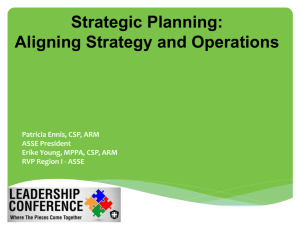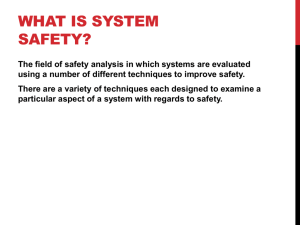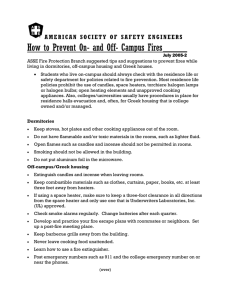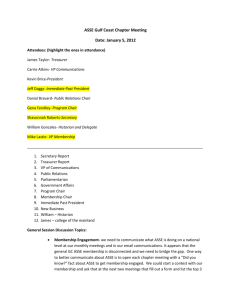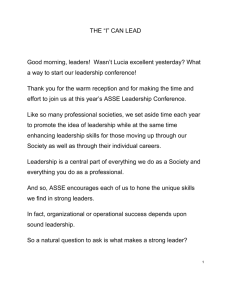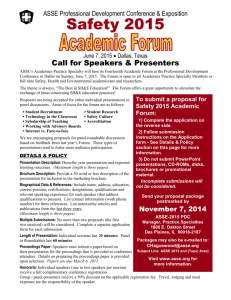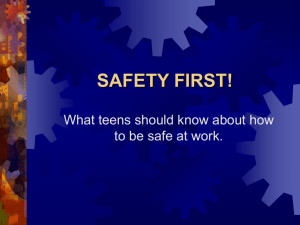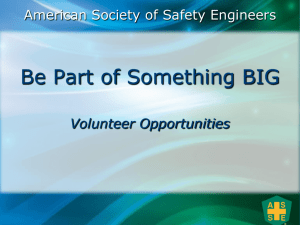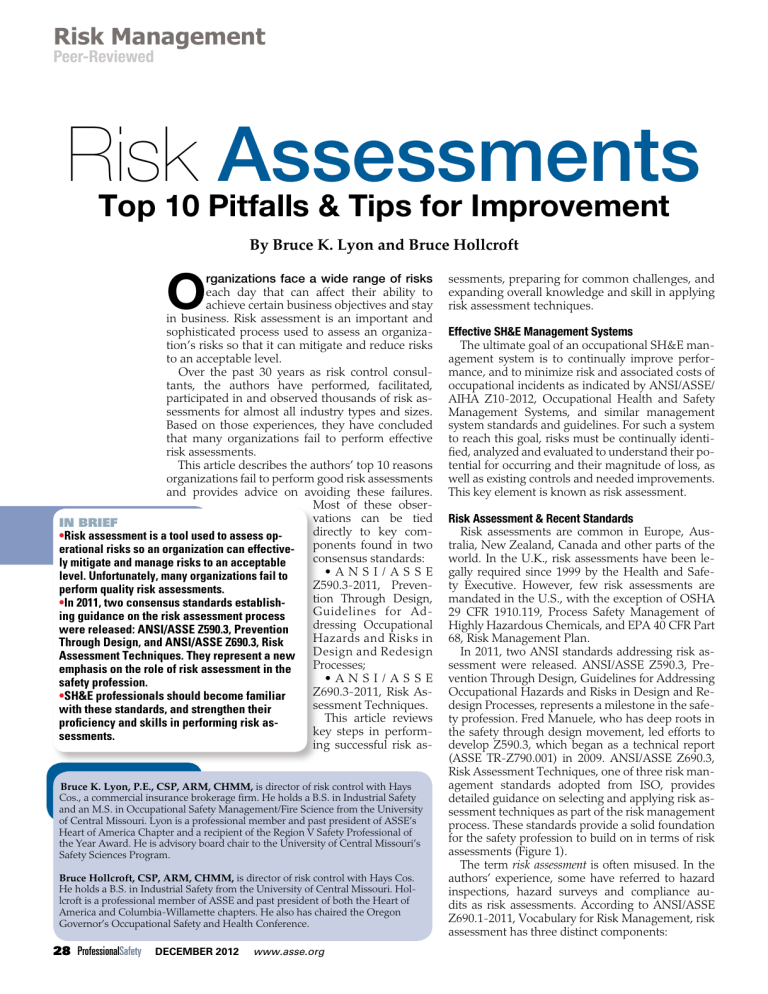
Risk Management Peer-Reviewed Risk Assessments Top 10 Pitfalls & Tips for Improvement By Bruce K. Lyon and Bruce Hollcroft O rganizations face a wide range of risks each day that can affect their ability to achieve certain business objectives and stay in business. Risk assessment is an important and sophisticated process used to assess an organization’s risks so that it can mitigate and reduce risks to an acceptable level. Over the past 30 years as risk control consultants, the authors have performed, facilitated, participated in and observed thousands of risk assessments for almost all industry types and sizes. Based on those experiences, they have concluded that many organizations fail to perform effective risk assessments. This article describes the authors’ top 10 reasons organizations fail to perform good risk assessments and provides advice on avoiding these failures. Most of these observations can be tied IN BRIEF directly to key com•Risk assessment is a tool used to assess operational risks so an organization can effective- ponents found in two consensus standards: ly mitigate and manage risks to an acceptable •ANSI/ASSE level. Unfortunately, many organizations fail to Z590.3-2011, Prevenperform quality risk assessments. tion Through Design, •In 2011, two consensus standards establishGuidelines for Ading guidance on the risk assessment process dressing Occupational were released: ANSI/ASSE Z590.3, Prevention Hazards and Risks in Through Design, and ANSI/ASSE Z690.3, Risk Assessment Techniques. They represent a new Design and Redesign Processes; emphasis on the role of risk assessment in the •ANSI/ASSE safety profession. Z690.3-2011, Risk As•SH&E professionals should become familiar sessment Techniques. with these standards, and strengthen their This article reviews proficiency and skills in performing risk askey steps in performsessments. ing successful risk asBruce K. Lyon, P.E., CSP, ARM, CHMM, is director of risk control with Hays Cos., a commercial insurance brokerage firm. He holds a B.S. in Industrial Safety and an M.S. in Occupational Safety Management/Fire Science from the University of Central Missouri. Lyon is a professional member and past president of ASSE’s Heart of America Chapter and a recipient of the Region V Safety Professional of the Year Award. He is advisory board chair to the University of Central Missouri’s Safety Sciences Program. Bruce Hollcroft, CSP, ARM, CHMM, is director of risk control with Hays Cos. He holds a B.S. in Industrial Safety from the University of Central Missouri. Hollcroft is a professional member of ASSE and past president of both the Heart of America and Columbia-Willamette chapters. He also has chaired the Oregon Governor’s Occupational Safety and Health Conference. 28 ProfessionalSafety DECEMBER 2012 www.asse.org sessments, preparing for common challenges, and expanding overall knowledge and skill in applying risk assessment techniques. Effective SH&E Management Systems The ultimate goal of an occupational SH&E management system is to continually improve performance, and to minimize risk and associated costs of occupational incidents as indicated by ANSI/ASSE/ AIHA Z10-2012, Occupational Health and Safety Management Systems, and similar management system standards and guidelines. For such a system to reach this goal, risks must be continually identified, analyzed and evaluated to understand their potential for occurring and their magnitude of loss, as well as existing controls and needed improvements. This key element is known as risk assessment. Risk Assessment & Recent Standards Risk assessments are common in Europe, Australia, New Zealand, Canada and other parts of the world. In the U.K., risk assessments have been legally required since 1999 by the Health and Safety Executive. However, few risk assessments are mandated in the U.S., with the exception of OSHA 29 CFR 1910.119, Process Safety Management of Highly Hazardous Chemicals, and EPA 40 CFR Part 68, Risk Management Plan. In 2011, two ANSI standards addressing risk assessment were released. ANSI/ASSE Z590.3, Prevention Through Design, Guidelines for Addressing Occupational Hazards and Risks in Design and Redesign Processes, represents a milestone in the safety profession. Fred Manuele, who has deep roots in the safety through design movement, led efforts to develop Z590.3, which began as a technical report (ASSE TR-Z790.001) in 2009. ANSI/ASSE Z690.3, Risk Assessment Techniques, one of three risk management standards adopted from ISO, provides detailed guidance on selecting and applying risk assessment techniques as part of the risk management process. These standards provide a solid foundation for the safety profession to build on in terms of risk assessments (Figure 1). The term risk assessment is often misused. In the authors’ experience, some have referred to hazard inspections, hazard surveys and compliance audits as risk assessments. According to ANSI/ASSE Z690.1-2011, Vocabulary for Risk Management, risk assessment has three distinct components: Figure 1 Risk Management Process •risk identification, which involves finding, recognizing and recording hazards; •risk analysis, which entails understanding consequences, probabilities and existing controls; •risk evaluation, which encompasses comparing levels of risk and considering additional controls. Since risk assessment is fundamental to the risk management process, SH&E professionals must be clear on what a risk assessment entails and how it is performed. This article describes 10 reasons why organizations fail to perform good risk assessments, and reviews key strategies to avoid these problems and improve the risk assessment process. The authors selected these particular failures based on their direct and indirect work experience as safety consultants in the insurance and SH&E consulting industries. Although the method used to select these common failures is not based on statistical data, the selected failures correlate with primary requirements found in ANSI/ASSE Z590 and Z690. Reason 10: Fail to Perform a Formal Assessment In many cases, risk assessments are simply not performed. Consider, for example, the Deepwater Horizon explosion. According to estimates, the losses from the offshore oil rig disaster caused 11 fatalities, cost $40 billion and released 4.9 million barrels of oil into the Gulf. BP’s internal investigation team concluded that a key cause of the explosion was that no risk assessment had been performed on the cement slurry barrier application. According to the team’s report, “The investigation team has not seen evidence of a documented risk assessment regarding annulus barriers” (BP, 2010, p. 36). The accuracy of cement slurry barriers was described as “critical” in the report, yet no formal risk assessment was performed. Unfortunately, BP is not alone. In ASSE’s (2011) webinar, “Prevention Through Design: Guidelines for Addressing Occupational Hazards and Risks in Design and Redesign Processes,” presenter Bruce Main quoted a study conducted by a Fortune 500 company which indicated that 65% of serious incidents had no previous risk assessment. This number may be indicative of other Fortune 500 companies, and supports the authors’ experience that many smaller companies perform few, if any, risk assessments. Organizations can cite many reasons to not perform risk assessments: •belief that since no significant incidents have occurred, the organization has adequately assessed and managed risks by informal means; •reliance on insurance coverage and outside risk control services to manage risks; •misconception that simple hazard identification and correction methods are adequate; •hazards-based and compliance-type approach; •fear of discovering and documenting certain risks that may be difficult to address or mitigate; •lack of knowledge and/or resources to perform a risk assessment internally; •no mandate or corporate requirement to perform risk assessment. Establishing the context (5.3) Risk assessment (5.4) Risk identification (5.4.2) Communication and consultation (5.2) Risk analysis (5.4.3) Monitoring and review (5.6) Risk evaluation (5.4.4) Risk treatment (5.5) Note. Adapted from ANSI/ASSE Z690.2-2011, p.21, by ANSI/ASSE, 2011, Des Plaines, IL: Author. In the U.S., many organizations have relied on checklist-and-hazard-inspection methods that focus on regulatory compliance, and prescribed hazards and conditions to evaluate workplace safety and health. Unfortunately, such methods do not provide a true measure of risk. An organization should have a strategy to determine where, when and how risks must be assessed as described in ANSI Z690.3 Section 4.2, Risk Assessment and the Risk Management Framework (p. 12). Basic criteria for establishing the need for risk assessment may include: •projects or tasks that have not had a formal risk assessment; •new facilities, processes or equipment; •when several risks are present or introduced that make it necessary to apply risk priorities in an organized manner; •when a risk could have serious consequences and where control measures are unclear; •where there is a planned change to equipment, machinery or a particular process (as outlined in ANSI Z10, 5.1.2, Design Review and Management of Change). Lack of proper risk assessment can lead to catastrophic results. Risks must be continually identified, analyzed and evaluated to understand their potential for occurring and their magnitude of loss, as well as existing controls and needed improvements. Reason 9: Fail to Define the Context & Objectives of the Assessment Without appropriate guidance, a risk assessment may wander aimlessly and far from its intended purpose. A quality risk assessment starts with establishing the objectives and context by defining basic parameters, scope and criteria. The purpose and scope of a risk assessment should be determined by those who will use the resulting information to make informed decisions. The purpose should be concise and avoid complex statements; it should be written so that everyone on the team can continuously refer to it in order to stay focused and avoid wandering too www.asse.org DECEMBER 2012 ProfessionalSafety 29 Figure 2 The ALARP Principle The ALARP Principle Unacceptable Region ALARP Region Steps must be taken to reduce risk to as low as reasonably practicable. 4 Immediate action required. Operation not permissible, except in rare and extraordinary circumstances. 3 Remedial action is to be given high priority. 2 Remedial action to be taken at appropriate time. 1 Remedial action is discretionary. Procedures are to be in place to ensure that this risk level is maintained. Negligible Risk Note. Adapted from ANSI Z690.3, by ANSI/ASSE, 2011, Des Plaines, IL: Adopted from ANSI Z690.3; Manuele Author. The potential for harm must be reduced until the cost of further reduction is disproportionate to the benefit gained— to the level of as low as reasonably practicable. far from the intended goal. Following is a sample purpose statement once used by the authors (although words such as “emergencies/disasters” and “impact” many need to be more precisely defined): “The purpose of this risk assessment is to determine the potential emergencies/disasters that could have the most impact on the organization.” Communicating the purpose and scope to the risk assessment team should include a common understanding of terminology to be used. For example, when using qualitative risk analysis, a clear explanation of the terms used and their meanings should be communicated and understood by the assessment team and management (ANSI/ASSE 2011c, p. 18) Determining the assessment’s scope can be even more complicated than its purpose, but it is as important to the success of the risk assessment. The endeavor needs a tightly defined beginning and end so the team is not tempted to take it further than intended or make it too complicated. For example, the assessment of potential emergencies/disasters might need some limitations. Should the assessment address only emergencies/ disasters at facility sites or should it include offsite events? Should it include natural, man-made or technological emergencies/disasters, or all of them? Setting the scope too narrow might prevent a hazard and the resulting risk from being identified and assessed; setting it too broad could prevent the risk assessment from achieving its true purpose. Again, input from those who will use the risk assessment to make decisions is crucial. Reason 8: Fail to Understand an Organization’s Acceptable Risk Level An organization must define its acceptable risk levels and incorporate them into the risk assessment process. Otherwise, paralysis by analysis will lead to wasting time and resources on acceptable risks, and possibly stall or short-circuit the process. For example, an organization with new management declared that every facility would perform a thorough risk assessment. With no specific guidance about the type or level of risks to include, many risks, including trivial ones, were collected; unfortunately, resources were consumed without identifying some important and serious risks. One 30 ProfessionalSafety DECEMBER 2012 www.asse.org of these unidentified risks later caused a serious fire and explosion. Had the organization defined and communicated acceptable risk levels and risk assessment criteria, the risk may have been identified and the incident avoided. Manuele (2010) suggests that safety professionals have not yet fully embraced the concept of acceptable risk. Some organizations promote zero risk as their primary SH&E goal. However, some residual risk will always remain. As described in ANSI/ ASSE/AIHA Z10, Appendix F, safety and health management goals should be specific, measurable, actionable, realistic and time-oriented. A zero risk goal is not realistic and should be redefined to an achievable and acceptable level for the organization. What is an achievable and acceptable level of risk? ANSI Z690.3 explains that the potential for harm must be reduced until the cost of further reduction is disproportionate to the benefit gained—to the level of as low as reasonably practicable (ALARP, Figure 2). The criteria used to determine this level should include the organization’s SH&E goals and the use of cost-benefit analyses of risks and their treatment; it also will be influenced by its culture and industry setting (ANSI/ASSE 2011c, p. 21). Typically, as an organization matures and improves its risk control measures, the acceptable risk level will move closer to the negligible risk level. Reason 7: Fail to Assemble the Best Team to Perform the Risk Assessment Depending on the assessment’s scope, a team of objective, knowledgeable, experienced and complementary personnel should be created. Unfortunately, some risk assessments are performed from a less-than-objective viewpoint or a single perspective. For example, a company near the Port of Oakland, CA, initially failed to include security in its risk assessment for emergency planning purposes. After the authors suggested that security be involved, civil unrest and train derailments were identified as significant risks. Soon after, Occupy Oakland occurred and the area was closed, but the company was prepared because it had included security. In some cases, risk assessments are performed just to document them in order to meet some internal or external requirement. Such assessments are often performed by limited teams and may be led by a dominant individual who is primarily focused on completing the task. Experience has shown that this leads to incomplete risk assessments where some hazards are not identified and risks are not fully assessed. Teams of three to 10 competent members seem to work well. Such teams usually offer sufficient perspectives on a risk assessment, yet are not too large to manage and keep focused. Team members should be selected based on their knowledge, experience and commitment to the effort, and will vary depending on the hazards and risks being assessed. For example, a team assessing a product might include representatives from research and development, design, engineering, production, quality, legal, sales, service, risk management and safety. A transportation risk assessment might include a driver, routing/scheduling, DOT compliance, service and maintenance, risk management and safety. These members can be directed to gather input from their departments if the process is not confidential because external parties often contribute to the risk assessment. Risk assessments are excellent opportunities for employee involvement, which is critical to the success of any safety effort. Employee involvement is required by all safety management system standards (e.g., ANSI/ASSE Z10, OHSAS 18001, OSHA VPP). It also is required by some state OSHA regulations and specific regulations such as OSHA’s process safety management standard. Employee involvement leads to a better risk assessment. Reason 6: Fail to Use the Best Risk Assessment Techniques To achieve desired results, an organization must properly match the technique used to the exposure. Many techniques are not well understood or used properly. Experience is important in proper selection and application. In some cases, it may be necessary to use more than one method. For example, a large die-casting operation relied strictly on checklist audits to identify and correct hazards. The checklists were not regularly reviewed or updated, and did not include specific risks such as condition and control of aluminum for the furnace. As a result, scrap aluminum containing moisture was placed in the furnace and a serious explosion of molten metal critically injured several employees. Many different risk assessment techniques exist, some complex (quantitative) and specific, and others more basic (qualitative) and broad in applica- tion. Certain techniques have specific applications. For example, hazard analysis and critical control points is often used in food and beverage processing. ANSI/ASSE Z690.3 describes 31 different techniques (pp. 22-25; Figure 3), while ANSI/ASSE Z590.3 features eight. Three risk assessment techniques are highlighted in ANSI Z590.3 as being more practical for most risk situations: preliminary hazard analysis, what-if/checklist analysis, failure modes and effects analysis (FMEA) (Figure 3). The technique selected should be justifiable and appropriate for the situation; provide useful results; and be traceable, verifiable and consistent. Selection criteria should be based on the assessment’s defined context and objectives (Reason 9) and should consider the following: •complexity of problem; •type and range of risks; •potential magnitude; •risk assessment team’s degree of experience; •available data; •regulatory requirements. In some cases, more than one technique may be needed. For example, an organization can use brainstorming to develop a list of concerns and qualified risks, then prioritize risks using a risk matrix (Figure 4, p. 32); this can be followed by a breakdown of each concern using a fishbone diagram or causeand-effect analysis. However, specific concerns, such as ergonomic risk factors, may not be fully identified or measured using standard risk assessment techniques. Specific tools that focus on ergonomic risks, such as the rapid upper limb assessment, the Snook tables, NIOSH’s lifting formula and similar tools, are available to assess ergonomic-related risk factors. The assessment and its output should be consis- Figure 3 Risk Assessment Tool Attributes Relevance of Factors Type of Risk Assessment Technique Description Resources and Capability Nature and Degree of Complexity Uncertainty Can Provide Quantitative Output LOOK-­‐UP METHODS Checklists Preliminary Hazard Analysis A simple form of risk identification Low Low Low No Identify hazards and situations that cause them Low High Medium No The technique selected should be justifiable and appropriate for the situation; provide useful results; and be traceable, verifiable and consistent. SUPPORTING METHODS What-­‐If Used by team to identify risks Medium Medium Any No What if/Checklist Analysis team identify risks using lists Medium Medium Any No SCENARIO ANALYSIS Fault Tree Analysis MORT Tree diagram starting with undesired event Identifys post-­‐incident design/procedural causes High High Medium Yes Medium Medium Medium No FUNCTIONAL ANALYSIS HAZOP Criticalities of deviations assessed Medium High High No FMEA Identifies failure modes and their effects Medium Medium Medium Yes Note. Adapted from ANSI Z690.3, Table A.2, by ANSI/ASSE, 2011, Des Plaines, IL: Author. www.asse.org DECEMBER 2012 ProfessionalSafety 31 Figure 4 Risk Assessment Matrix Frequency (likelihood of occurrence) Every year 1 to 5 years 5 to 10 years > 10 years Almost never Incidental < $10K 5 4 3 2 1 The assessment and its output should be consistent with the risk criteria established in its scope and purpose. Severity (consequences of incident) Minor Serious Major Catastrophic $10 to 25K $25 to 100K $100 to 500K $500K > 10 15 20 25 8 12 16 20 6 9 12 15 4 6 8 10 2 3 4 5 tent with the risk criteria established in the assessment’s scope and purpose. As noted, ANSI/ASSE Z690.3 contains extensive information on 31 different risk assessment techniques. Annex A provides a table (Comparison of Risk Assessment Techniques) that lists each technique’s application and attributes to help users make the proper selection, and Annex B provides greater detail on each technique’s uses, strengths and limitations. Reason 5: Fail to Be Objective & Unemotional in the Risk Assessment Process An objective, experienced facilitator can keep the risk assessment focused on its purpose and goals. Sometimes, team members can be too close to the situation or be less-than-objective due to past experience. An experienced facilitator can keep the process objective. If team members have a memorable experience, they may exaggerate the real potential frequency and severity. Reading a dramatic article, hearing a dynamic speaker or a recent news feature also can skew perceptions. In addition, each member has personal issues that tend to be overvalued. This can interfere with the process, especially if it comes from a member with a strong personality. The effects of such issues can be moderated by a well-rounded assessment team or an experienced facilitator. The right comparisons can be made, and questions can be asked to bring the perception back in line with reality. This must be done with much care and consideration so as to not discredit or alienate a member with a strong position on an issue. Reason 4: Fail to Identify Hazards That Create Risks & Consider Combined Whole-System Risk If a hazard is not recognized or is simply missed, the resulting risk is not assessed. The authors have observed some assessments that identified physical hazards, yet failed to uncover less obvious hazards such as occupational health exposures. Therefore, the SH&E professional should consider the systems approach while performing risk assessments. Consider this example. A large manufacturing operation initiated a corporate-wide effort to identify and manage its risks. The scope of the assessment process was broad and was conducted by plant personnel who had limited training. The assessors identified safety-related hazards, but did not recognize potential health risks related to operations such as coating and finishing tasks. Industrial hygiene and ergonomic risks were present, but were not identified. Other significant risks were missed in some plants. The inconsistencies and missed risks had to be addressed in a second assessment by an outside consulting group. Risk assessments performed by a single indi- 32 ProfessionalSafety DECEMBER 2012 www.asse.org vidual have limited value as well. An individual’s experience level, knowledge and skill in hazard identification will dictate the assessment’s direction and focus. If an organization does not use a wellrounded assessment team to capture a broader spectrum of risks (Reason 7), the assessment is left to the individual risk assessor’s comfort level with certain types of exposures (e.g., machine guarding, electrical, ergonomics, industrial hygiene), which limits the results. Depending on complexity, a false sense of security may develop, with critical risks remaining unidentified and untreated. The potential effect of combined risks also may be missed. Risk assessment teams that identify and catalog individual hazards as line items may miss the potential for certain risks occurring at the same time and producing synergistic effects. For example, FMEA typically takes each failure as a single event and analyzes each failure individually for its causes and effects. Certain combinations of risks create greater risk. For instance, in the meat processing industry, cold temperatures combined with hand-arm vibration from pneumatic hand tools increase risk of soft-tissue damage (ANSI/ ASSE 2011a, Section 7.4.5). Sound risk assessments account for the combined or synergistic effects of multiple risks rather than view them as mutually exclusive. Whole-system risk must be considered in the assessment process to properly manage actual risk. Reason 3: Fail to Consider the Hierarchy of Controls & Fail to Prioritize Based on Risk PPE and administrative measures should not be the default choice. Although they may be the easiest to implement, they are the least effective and reliable. Failure to properly apply the hierarchy of controls often results in a failure to control risk to an ALARP level. An organization should have a strategy for prioritizing control measures based on risk level and degree of exposure to optimize efforts and resources. ANSI/ASSE Z590.3 addresses the hierarchy of controls, as well as selecting and implementing risk reduction and control methods. ANSI/ASSE Z690.3 also covers controls assessment. Both require consideration of the hierarchy on initial risk assessment and those performed after controls are implemented. The hierarchy presents controls in order from most effective to least effective (Figure 5). Applying this hierarchy properly should become second nature for every SH&E professional and standard practice for organizations. It serves to assess risk more accurately and helps continuously improve controls. Reason 2: Fail to Perform Risk Assessment During the Design/Redesign Phase ANSI/ASSE Z590.3-2011 emphasizes the importance of using risk assessment during the design/ redesign stage. While this seems obvious, organizations rarely perform a thorough risk assessment during design and redesign phases. Consider this example. While designing a new manufacturing facility, a large global organization Figure 5 Hierarchy of Controls Note. Adapted from ANSI/ASSE Z590.3-2011, p. 24, by ANSI/ASSE, 2011, Des Plaines, IL: Author. held a planning session to determine the tasks, resources and timetables needed to open the new operation. The planning session involved production, engineering, maintenance, quality, human resources, SH&E personnel and one of the authors. As the planning team worked through the steps, the author suggested that a risk assessment was necessary. The group did not see this as a feasible time to conduct an assessment and was more comfortable performing it after the facility, equipment and employees were in place. The group believed the corporate design and engineering department was addressing necessary requirements. On its Prevention Through Design website, NIOSH states: One of the key elements of this standard is that it provides guidance for “life cycle” assessments and a design model that balances environmental and occupational safety and health goals over the life span of a facility, process or product. The standard focuses on the four key stages of occupational risk management. The pre-operational, operational, post incident and post-operational stages are all addressed within. The fact that operations, equipment and products have a life cycle and that risk may change during various stages of the cycle should be considered in the risk assessment. Figure 6 depicts how ANSI Z590.3 illustrates the typical design concept through decommissioning process. The standard explains the use of risk avoidance in the early design phase: In the early design phases, there are no risks, yet, to be avoided, eliminated, reduced or controlled. Designers start with a blank sheet of paper, or a blank screen in a CAD system. They have opportunities to avoid hazards altogether in the design concept, preliminary design and detailed design stages. (p. 45) In the authors’ experience, many ill-conceived workplace designs force at-risk practices and conditions that lead to operator error and injury. However, many organizations do not even think about assessing risk during design and redesign stages, thus missing an opportunity to save money and mitigate risks. Instead, they wait to address risks until project completion or installation, and many times not until an incident or significant loss occurs. This approach is aided by: •inadequate education and training in safety principles for most designers and engineers; •tradition and culture; •lack of forethought and planning time built into the design process. As outlined in ANSI/ASSE Z590.3, organizations should develop strategies for conducting design safety reviews at the design stage and risk assessments at critical life-cycle phases of facilities, installations and equipment. It also should incorporate risk assessment into the management of change process and include risk assessment requirements for suppliers. Risk assessment at the design/redesign phase may be the most overlooked risk management tool available to organizations. Simply put, risk assessments should be a standard practice during the design and redesign phase. Reason 1: Fail to Communicate . . . Before, During & After the Risk Assessment Successful risk assessment depends on effective communication with stakeholders before, during and after the process, otherwise the result will be a less-effective assessment. A quality risk assessment involves stakeholders throughout the process and seeks their input. Stakeholders include internal personnel, as well as customers, investors, partners, suppliers and vendors. Investigators determined that NASA’s space shuttle Columbia explosion on Feb. 1, 2003, which claimed seven lives, was partially due to a lack of effective communication of critical safety information. They concluded that organizational causes, including lack of communication, contributed to the incident. Cultural traits and organizational practices detrimental to safety were allowed to develop, including: reliance on past success as a substitute for sound engineering practices . . . organizational barriers that prevented effective Successful risk assessment depends on effective communication with stakeholders before, during and after the process. A quality risk assessment involves stakeholders throughout the process. Figure 6 Typical Design Concept Through Decommissioning Note. Adapted from ANSI/ASSE Z590.3-2011 , by ANSI/ASSE, 2011, Des Plaines, IL: Author. www.asse.org DECEMBER 2012 ProfessionalSafety 33 communication of critical safety information and stifled professional differences of opinion; lack of integrated management across program elements; and the evolution of an informal chain of command and decisionmaking processes that operated outside the organization’s rules. (CAIB, 2003, p. 9) Communication is a provision of both ANSI/ ASSE Z690.3 and ANSI/ASSE Z590.3. Communication also is required by virtually all safety and health management standards such as ANSI/ASSE Z10, OHSAS 18001 and OSHA VPP, yet it is seldom done well. As a result, poor communication is often identified as a major contributor to poor outcomes such as injuries. As with many other functions, people should make it a priority to communicate effectively when performing risk assessments. Those involved should consider who could help them conduct the risk assessment more effectively. For example, they could ask members of their departments for input. Alternatively, they should think about who might be interested and benefit from the risk assessment that is being performed, and share the outcome. Conclusion SH&E professionals should have a firm understanding of the risk assessment process and techniques described in ANSI/ASSE Z590.3 and ANSI/ ASSE Z690.3. To avoid the 10 failures described, SH&E professionals should consider these principles and practices in the risk assessment process: 10) Perform a formal risk assessment. 9) Define the assessment’s context and objectives. 8) Understand the acceptable risk level. 7) Assemble the best team to perform the risk assessment. 6) Use the best risk assessment technique(s). 5) Be objective and unemotional in the risk assessment process. 4) Identify hazards that create risk, and consider whole-system risk. 3) Apply the hierarchy of controls and prioritize based on risk. 2) Perform risk assessment during the design/ redesign phase. 1) Communicate before, during and after the risk assessment. Well-executed risk assessments enable organizations to make the right decisions, protect their assets, and properly manage their risks as they operate, grow and improve their businesses. SH&E professionals must be leaders in the risk assessment process. PS References ANSI/ASSE. (2011a). Prevention through design: Guidelines for addressing occupational hazards and risks in design and redesign processes (ANSI/ASSE Z590.32011). Des Plaines, IL: Author. ANSI/ASSE. (2011b). Risk management principles and guidelines (ANSI/ASSE Z690.2-2011). Des Plaines, IL; Author. ANSI/ASSE. (2011c). Risk assessment techniques 34 ProfessionalSafety DECEMBER 2012 www.asse.org (ANSI/ASSE Z690.3-2011). Des Plaines, IL; Author. ANSI/ASSE. (2011d). Vocabulary for risk management (ANSI/ASSE Z690.1-2011). Des Plaines, IL: Author. ANSI/ASSE/AIHA. (2012). Occupational health and safety management systems (ANSI/ASSE/AIHA Z102012). Des Plaines, IL: Author. ASSE. (2011, Nov. 30). Prevention through design: Guidelines for addressing occupational hazards and risks in design and redesign processes [Webinar]. Retrieved from http://eo2.commpartners.com/users/asse/session .php?id=7823 BP. (2010, Sept. 8). Deepwater Horizon accident investigation report. Retrieved from www.bp.com/live assets/bp_internet/globalbp/globalbp_uk_english/ incident_response/STAGING/local_assets/down loads_pdfs/Deepwater_Horizon_Accident_Investi gation_Report.pdf British Standards Institution (BSI). (2007). Occupational health and safety management systems: Requirements (OHSAS 18001:2007). London: Author. Cantrell, S. & Clemens, P. (2009, Nov.). Finding all the hazards: How do we know we are done? Professional Safety, 54(11), 32-35. Christensen, W.C. & Manuele, F.A. (2000). Safety through design. Itasca, IL: National Safety Council. Clemens, P.L. (2000, April). Many hazard analyses conceal whole-system risk. Professional Safety, 45(4), 31-33. Clemens, P. (2005, May). Zero-injury workdays: An effective metric? Professional Safety, 50(5), 40-41. Columbia Accident Investigation Board (CAIB). (2003). Columbia accident investigation board report (Vol. 1). Washington, DC: NASA. Retrieved from www .nasa.gov/columbia/home/CAIB_Vol1.html DeRosier, J., Stalhandske, E., Bagian, J.P., et al. (2002, May). Using healthcare failure mode and effects analysis: The VA national center for patient safety’s prospective risk analysis system. The Joint Commission on Accreditation of Healthcare Organizations, 28(5), 248-267. EPA. (2004). Risk management plan (RMP) rule. Washington, DC: Author. Retrieved from www.epa .gov/oem/content/rmp Health and Safety Executive. Frequently asked questions. London: Author. Retrieved from www.hse.gov .uk/risk/faq.htm#q7 Heidel, D. (2011, Sept. 22). Prevention through design standard [Web log]. Washington, DC: U.S. Department of Health and Human Services, CDC, NIOSH. Retrieved from http://blogs.cdc.gov/niosh-science-blog/2011/09/ ptd-2 Lyon, B.K. (2001, Oct.). Behavior sampling of theme park ride operators. Professional Safety, 46(10), 35-42. Manuele, F.A. (2008). Advanced safety management: Focusing on Z10 and serious injury prevention. Hoboken, NJ: John Wiley & Sons. Manuele, F.A. (2008, Oct.). Prevention through design: Addressing occupational risks in the design and redesign processes. Professional Safety, 53(10), 28-40. Manuele, F.A. (2010, May). Acceptable risk: Time for SH&E professionals to adopt the concept. Professional Safety, 55(5), 30-38. OSHA. (1992). Process safety management of highly hazardous chemicals. Washington, DC: U.S. Department of Labor, Author. Retrieved from www.osha.gov/pls/ oshaweb/owadisp.show_document?p_table= ­STANDARDS&p_id=9760 OSHA. (2003). Voluntary protection programs: Policies and procedures manual. Washington, DC: U.S. Department of Labor, Author. Retrieved from www.osha.gov/ OshDoc/Directive_pdf/CSP_03-01-003.pdf
